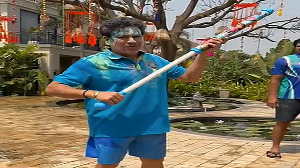On May 11, the day the Bahujan Samaj Party romped into the Uttar Pradesh Assembly with a simple majority, party chief Mayawati held a press conference at the BSP Kendra which holds statues of B R Ambedkar, Kanshi Ram and Mayawati herself.
Given a prominent place among this triumvirate of Dalit icons was a lone Brahmin, Satish Chandra Mishra, former advocate general of Uttar Pradesh and said to be the architect of Mayawati's Dalit-Brahmin combination. He shared the dais with Mayawati and also accompanied her to Raj Bhawan to stake claim to form a government in Uttar Pradesh.
For those who had been associated with Mayawati in the past, this scenario as well as her victory capturing the 13.8 per cent Brahmin vote in the state appeared to be an impossible dream. Indeed, Mishra, who was advocate general in UP in September 2003, was himself reluctant when Mayawati asked him to join the BSP.
He thought about what he, a Brahmin, could do in a party which was completely Dalit-centric. Mayawati, according to Mishra himself assured him that she was not anti-Brahmin and that he would be given an important role in the party. As she watched Mishra handle and win cases in which BSP MLAs defected to the Samajwadi Party in droves, she was convinced that if anyone could win over the Brahmins it was Mishra.
Mishra's father Tribeni Prasad Mishra was a judge in the Allahabad high court and was also considered a better lawyer than his son. Mishra junior, a law graduate from Allahabad University, however was at the right place to make history. In January 2004, when a Samajwadi wave was hitting Uttar Pradesh, Mishra joined the BSP as a national general secretary. Before this, Mishra was apolitical and had fought cases representing all political parties in his 31-year-old law career.
Mayawati's appointment of Mishra as advocate general and her wooing of him as a "non-political" caste leader made a politician out of him. He and Mayawati rode out the 2004 general elections, and following Deng Xiaoping's dictum to the Chinese, kept their head down and nose to the grindstone.
Mishra, the only one after Mayawati to be given the use of a helicopter for campaigning, hit nearly all 70 districts of Uttar Pradesh. He travelled nearly 22,000 km in the state and held Brahmin rallies between July-September 2006. More than that, to drive home the inclusive message of the BSP, every district had a bhaichara badao samiti with at least 400 members, 300 of whom would be Brahmins and 100 Dalits.
Mishra cashed in on the fact that the Brahmins were uncomfortable with a Thakur and OBC-dominated BJP. The old Congress plank of Brahmins and Dalits with Muslims included was used in the case of the BSP. Those who know Mayawati say that the BSP chief finds it difficult to share the limelight with anybody. Yet Mishra has consistently remained as an important aide, never over-stepping his boundaries and making sure his own people, like Mahona MLA Nakul Dubey, find prominence in the party. Some compare him to Samajwadi Party chief Amar Singh in his importance to his party leader; others say that Mishra is far more cultivated and cultured than Singh. "He will never court limelight like Singh. As a Brahmin, he is used to being the power behind the throne unlike the Thakur that Amar Singh is," said a BSP leader.







 © 2025
© 2025